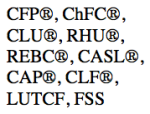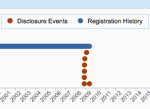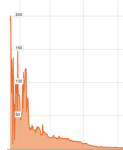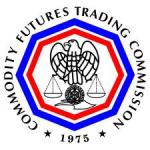
Is this it?
Last year, our nostalgia for the dot-com bubble was rekindled when Finra sanctioned Rodman & Renshaw LLC, and its research analyst, Lewis Boreas Fan, for allegedly reviving the lost art of offering a company favorable research analyst coverage in exchange for the company’s investment banking business. As you may recall, Finra thought Mr. Fan’s romantic emails contained a secret “coded” discussion of an illicit research-for-banking relationship. We weren’t so sure. See FINRA Sanctions Research Analyst Who Wanted Only to Be Loved. If true, though, the Fan case was the last breath of a long dying dot-com era practice.
Or was it? According to the New York Times and Investment News, this lost art may be alive and well. It was not, as thought, killed off by the massive fines and suspensions, or the blizzard of intricate new rules, issued in the wake of the 2003 Global Research Analyst Settlements. While these measures inflicted severe wounds, more violence is apparently necessary to slay this dot-com era zombie. According to these publications, Finra has requested information from several investment banks on research analyst participation in pitches for IPO business. This type of Finra request is usually in a letter that says, in essence:
Dear Investment Bank: Give us the following 37 categories of documents from your files, including emails in native format from the following 26 people on the following 19 topics, and provide written answers to the following 35 questions, and provide documents and data and calendar entries and text messages and tweets and notes and phone records concerning the following 27 IPO pitches, and identify the persons most knowledgeable on the following 11 subjects. Failure to respond fully and truthfully may result in your being banned from the industry. Best regards, Finra.

Person Familiar with the Matter.
Such requests are typically kept confidential by Finra, and by the investment banks receiving the request. So how do we know Finra sent out requests for information? Because “a person familiar with the matter” said so, but declined to be identified. Apparently somebody at an investment bank couldn’t keep a secret (perhaps it was an information-wants-to-be-free type of guy, so in vogue these days). Anyway, someone leaked, and it ended up in the New York Times and Investment News. (Incidentally, if you are ever an unidentified person familiar with a matter, send us an email at FinanciallyRegulated).
The Pitch
Here’s some background on Finra’s apparent concern. When a company decides to do an initial public offering, it needs skilled and experienced investment bankers to do the paperwork. Just kidding, a horde of junior associates in a big conference room at a major law firm does the paperwork, around the clock, with countless tedious revisions, over take-out food from India Flavor Quality, while their visual acuity degrades from 20/20 to something like 87/300 (Note to law students: the sexy side of investment banking is not the legal side).
When a company does an IPO, it needs buyers for the shares – the more the better – and this is where investment banks come in handy. Investment banks have brokerage affiliates with thousands of wealthy institutional and individual investor clients, and also have relationships with other brokerage firms with thousands of such clients. Massive sales channels. This is what an investment bank has and the company needs. For this service, investment banks take a huge cut of the IPO proceeds. But the hugeness of the cut is negotiable. It ranges from huge, to mega huge, to ginormous huge, to did-the-company-get-any-funds-out-of-this? huge. Given the room for negotiation on the hugeness, a company will shop around.

A Recent IPO Handled by Our Competitor.
The company will invite the bankers over for coffee and bagels, and the bankers will use Powerpoint to highlight their past successful IPOs, while skillfully avoiding discussion of the IPOs that they botched. Their botched IPOs will, however, be featured in the Powerpoints of the competing banks.
The question Finra is apparently looking at is this: when the investment bankers make a pitch to a company for its IPO business, do the bankers bring with them the research analyst from their firm who would later “cover” the company after it goes public? That is, do they bring with them the analyst who would write research reports about the company and issue buy, hold, or sell recommendations? And if they do bring the analyst, what role does the analyst play at the pitch?
Perhaps the analyst discusses the market, the industry, Fed policy, the IPO climate, or some other generalized financial matter to display the firm’s knowledge and savvy. Is Finra okay with that? Perhaps so. What is not okay, however, is the analyst suggesting that his research reports will be favorable if the company hires his bank for the IPO. That’s a clear no-no under the rules. Investors rely on research reports, the theory goes. They are  disappointed when supposedly objective research reports are slanted in a favorable direction as a kick-back for prior IPO business. That’s not nice to investors, the theory goes. Finra banned this type of quid-pro-quo in the aftermath of the dot-com crash through a set of rules designed to prevent conflicts of interest. These rules do not prohibit in-house analysts from covering companies that are customers of the investment bank. Instead, the rules seek to micromanage the possible conflicts in tedious detail (discussed here). The effect of these rules is to create a “wall” between the research analysts on one side, and the investment bankers on the other. The wall prohibits various types of communication and cooperation between the departments. This imaginary wall is usually called a “Chinese Wall.”
disappointed when supposedly objective research reports are slanted in a favorable direction as a kick-back for prior IPO business. That’s not nice to investors, the theory goes. Finra banned this type of quid-pro-quo in the aftermath of the dot-com crash through a set of rules designed to prevent conflicts of interest. These rules do not prohibit in-house analysts from covering companies that are customers of the investment bank. Instead, the rules seek to micromanage the possible conflicts in tedious detail (discussed here). The effect of these rules is to create a “wall” between the research analysts on one side, and the investment bankers on the other. The wall prohibits various types of communication and cooperation between the departments. This imaginary wall is usually called a “Chinese Wall.”
Where do we keep the Chinese Wall?
Nobody seems to know why these imaginary walls are called “Chinese Walls.” The prevailing theory is that they are named after the Great Wall of China, but there are many other compelling theories (but not compelling enough to recount here). Not everyone likes the term. For example, in 1988, Judge Low of the California Court of Appeal took great offense at the parties’ use of the term in a litigation. He wrote a concurring opinion solely to take issue with the phrase:
The enthusiasm for handy phrases of verbal shorthand is understandable. Occasionally, however, lawyers and judges use a term which is singularly inappropriate. “Chinese Wall” is one such piece of legal flotsam which should be emphatically abandoned. The term has an ethnic focus which many would consider a subtle form of linguistic discrimination. Certainly, the continued use of the term would be insensitive to the ethnic identity of the many persons of Chinese descent. Modern courts should not perpetuate the biases which creep into language from outmoded, and more primitive, ways of thought.
See page 11 here: Peat, Marwick, Mitchell & Co. v. Superior Court. Judge Low was not done there. He goes on to explain the history of discrimination against those of Chinese descent, how the Chinese should not be associated with “silence and secrecy,” and then urges the reader to imagine the insult that would obtain if we used the image of “the Eiffel Tower, the Great Pyramid of Cheops, or the Colossus of Rhodes.” Judge Low concludes:
It is necessary to raise a clenched cry for jettisoning the outmoded legal jargon of a bygone time. If the image of a wall must be used, perhaps ‘ethics wall’ is more suitable phraseology.
A “clenched cry”? This all sounds a bit off. But, fair enough.
Where do we Keep the Ethics Wall?
Finra’s information requests will likely seek to identify the scope and efficacy of the Ethics Walls inside the investment banks. Finra will review the policies and procedures creating and implementing the wall, as well as evidence that the wall works as intended. As mentioned, this is usually by letter that contains a large number of specific requests for documents, data and written answers. The response to Finra is typically handled by junior associates at a major law firm working in a small conference room next to the big conference room where associates are handling IPO paperwork (the main difference: only the IPO lawyers can bill their meals from India Flavor Quality to the client, and the IPO lawyers are more likely to have windows in their conference room). After Finra receives the responses, it may send follow-up requests. It may also conduct interviews.
Along the way, the banks will beg for multiple extensions of the time to submit responses. Finra will grant some requested extensions, but not others. The nights and weekends of junior associates will disappear or suddenly reappear based on whether an extension is granted. Finra will then review the information collected. It can use the information to identify and develop new rules. Also, if it uncovers wrongdoing at an investment bank, it can open an inquiry. This is often followed by the threat of an administrative action against the firm for rules violations. Most such cases settle in the form of a Letter of Acceptance, Waiver and Consent. The investment bank agrees to certain sanctions, but does not admit liability, and Finra agrees to end the investigation and not bring an administrative action. But we are getting ahead of ourselves.
Most interesting is how Finra will respond from a rulemaking perspective should it find evidence of widespread continuing violations of ethics walls. That is, will Finra go beyond the current rules, which seek only to micromanage the potential conflicts, and unveil something more substantial? Maybe an outright ban on analyst coverage of companies that are customers of the affiliated investment bank? Something akin to taking off the zombie’s head? We’ll have to wait and see. For now, perhaps the unidentified “person familiar with the matter” will keep the press apprised of how the response to Finra is coming along.
Published by Jeremy L. Bartell
 Financially Regulated is published by Jeremy L. Bartell, a long-time admirer of Wall Street and its interesting cast of regulators. Jeremy is an attorney with Bartell Law in Washington D.C. He represents financial professionals nationwide in Finra inquiries and investigations, Finra arbitration, securities employment disputes and registration and disclosure matters.
Financially Regulated is published by Jeremy L. Bartell, a long-time admirer of Wall Street and its interesting cast of regulators. Jeremy is an attorney with Bartell Law in Washington D.C. He represents financial professionals nationwide in Finra inquiries and investigations, Finra arbitration, securities employment disputes and registration and disclosure matters.























What do you think?